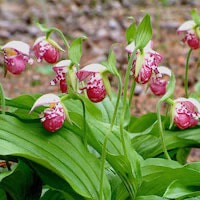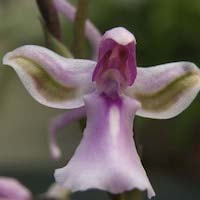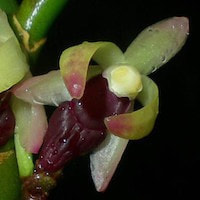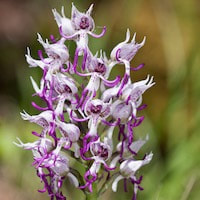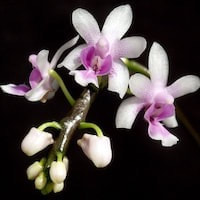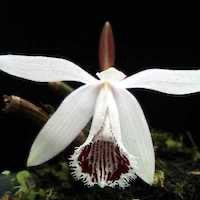WOR10- Women's Oriental 10 - In a pepper world
|
Native Singaporean Orchid notes: Sophrolaeliocattley
Sophrolaeliocattleya, a hybrid of Lc Aloha Case 'Hawaiian Style' and Slc Kauai Starbright, is prized for its stunning appearance and captivating fragrance. This compact orchid displays vibrant pink flowers with a darker pink lip, making it visually striking. Its delightful scent enhances its appeal, making it popular for various uses, including in the Oriental 10 (Women) team-building perfume workshop. This hybrid's ability to produce large, fragrant flowers has earned it acclaim and awards, reflecting its outstanding qualities in both beauty and fragrance. Its presence in the workshop enriches the experience, symbolizing unity and creativity through nature's beauty.
|
Therapeutic Orchid notes:
|
Cypripedium guttatum Sw.
Cypripedium guttatum Sw., known as Zidianshao Lan in Chinese and Banhuashaolan in Chinese medicine, is a notable orchid species valued for its pink flowers blooming from May to July. It thrives in diverse habitats, adapting well to both open and shady environments. In traditional medicine, its roots and leaves are used in eastern Russia and Siberia to treat epilepsy, showcasing its cultural significance in neurological health. This underscores the importance of preserving such orchids for their medicinal benefits and contributions to holistic healing practices. |
|
Hemipilia flabellata Bureau & Franch
Hemipilia flabellata Bureau & Franch, known as Duyeyizhi Hua (one leaf flower), Meteor rain grass, and Shanchunshehui Lan in Chinese, is a unique orchid thriving in damp, humus-rich soil and mossy areas of limestone forests at elevations of 2500 to 3200 meters in regions like Sichuan, Yunnan, Tibet, and Myanmar's Shan state. In Chinese medicine, it's valued for its lung-moistening properties, treating dry coughs and respiratory issues. It's also used for tuberculosis, trauma, excessive sweating, and renal colic, underscoring its role in traditional healing and the cultural importance of preserving botanical resources for future medicinal applications. |
|
Luisia curtisii Seidenf.
Luisia curtisii Seidenf., known as Kho Sing in Thai, is a widespread orchid species across Southeast Asia, found in Thailand, Cambodia, Vietnam, Peninsular Malaysia, Borneo, and the Philippines. Valued in traditional Thai medicine, the entire plant is used for its diuretic properties, aiding in increased urine production. This makes it beneficial for conditions like edema. Its use underscores the cultural heritage of natural remedies, reflecting the deep-rooted knowledge of botanical resources in promoting health and well-being across generations. |
|
Orchis simia Lam.
Orchis simia Lam., known in Turkish as Tavsantopugu, topanbas, solmazsoluk, and puskullu, is a versatile orchid species found across Europe, Iran, and North Africa. It thrives in various habitats, from meadows to sparse forests, preferring sunny locations with neutral or limestone soils, at elevations up to 1550 meters. Orchis simia is valued in traditional Iranian and Turkish medicine for its tubers, used to make Salep, a nourishing beverage rich in bioactive compounds like loroglossin and anthocyanins. Salep is cherished for its invigorating properties, underscoring orchids' cultural importance in herbal practices and the need to sustainably manage these botanical resources for future use. |
|
Phalaenopsis deliciosa Rchb. f. syn. Kingidium deliciosum (Rchb. f.)
Phalaenopsis deliciosa Rchb. f., known as Xiaoe Lan (small moth orchid) and Dajiannanghudie Lan in Chinese, is a small-sized orchid species forming clumps through basal shoots. It is widely distributed from Sri Lanka and India to parts of Southeast Asia, including Yunnan, Myanmar, Thailand, Malaysia, and the Philippines. Found in riverine forests up to 300 meters elevation, it thrives in balanced light and humidity conditions. In Taiwanese herbal medicine, the whole plant is valued for dispelling cold and wind while clearing dampness, suggesting its effectiveness in treating related ailments and promoting overall well-being. This usage reflects its cultural importance and supports traditional healing practices across its range, highlighting the orchid's role in community health and the importance of preserving such botanical knowledge for future generations. |
|
Pleione humilis (Sm.) D. Don,
Pleione humilis (Sm.) D. Don, also known as Pleione diantha Schltr., Epidendrum humile Smith, Coelogyne humilis (Smith) Lindl., and Cymbidium humile (Smith) Lindl., is an orchid species esteemed for its historical significance and diverse names. In Nepal, it's called Hathi tauke, referring to its flower's resemblance to an elephant head, and Shaktigumba. Locally, its pseudobulbs are used as a paste for healing cuts and wounds, showcasing its potential in traditional medicine. Moreover, its powdered form is consumed as a tonic, highlighting its role in promoting overall health and well-being. This orchid's use underscores the cultural wisdom of Nepalese communities in harnessing natural resources for medicinal purposes, sustaining traditional healing practices, and supporting local health traditions. |
Other scent note
Sage, Cinnamon, cardamom, Ambertone, Musks, Spice mix, Choya Loban Hemoki, patchouli, opoponax
Download the guided mediation that works best with this Orchid fragrance oil
| women_oriental_essential_oil_orchi_00010.mp3 | |
| File Size: | 91135 kb |
| File Type: | mp3 |

